A route concept study on the Ahmedabad - New Delhi connection
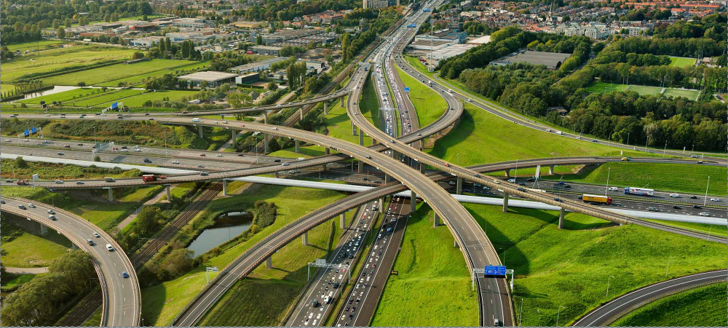
In this report the potential of using hyperloop technology to connect Ahmedabad and New Delhi in India is explored. The report includes projected passenger volumes, travel demand projections, and potential travel choice changes. It suggests that the 2, 4, and 14-hub options all have sufficient merit and recommends further project planning exercises through a collaborative partnership between Indian Railways and Hardt. Furthermore, the report recommends considering hyperloop as an intervention case by 2031 and as an alternative to high-speed rail for future high-speed corridors across India.
Strategic context
India's National Rail Plan (NRP) is an ambitious 30-year vision that aims to create a "future-ready" rail system by 2030 (see figure below). The plan also sets a goal to shift rail's share in freight transport to 45% by 2050. As the global mobility mix evolves over time, planners must consider the emergence of new modes, such as automated vehicles and drones, alongside the continuous innovation of existing modes. It is crucial to evaluate the opportunities these modes bring to fully realize their expected benefits. With hyperloop technology expected to commercialize in the 2030s, its potential to expand India's high-speed network and offer additional benefits to citizens and visitors deserves further exploration.
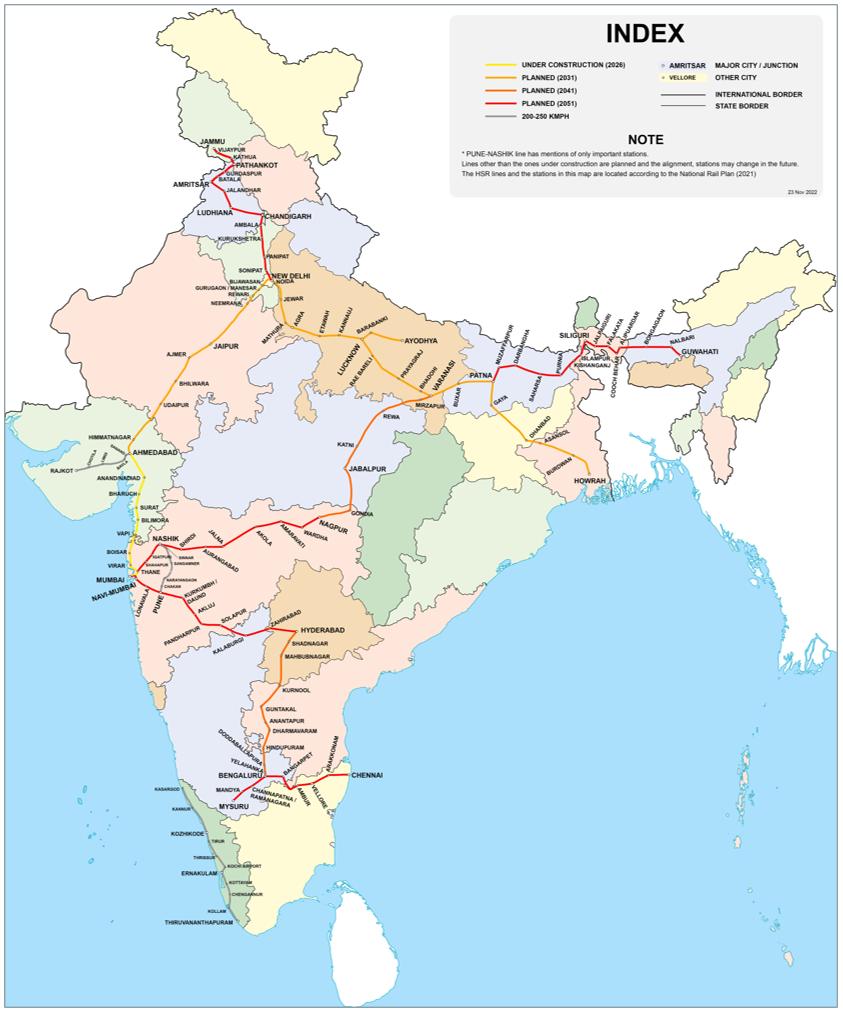
Challenges and opportunities
India faces three major transportation challenges: urban and rural disparities, rapid motorization and congestion, and slow travel times. To achieve socioeconomic integration between urban and rural regions, journey times must be reduced to decrease the need for migration to urban centers for social and economic opportunities. The rapid increase in car ownership in India (see chart below) has resulted in severe environmental and quality of life issues, such as air pollution and road congestion. Additionally, road and rail services are less competitive with aviation due to density and crowding issues, which leads to slower travel times.
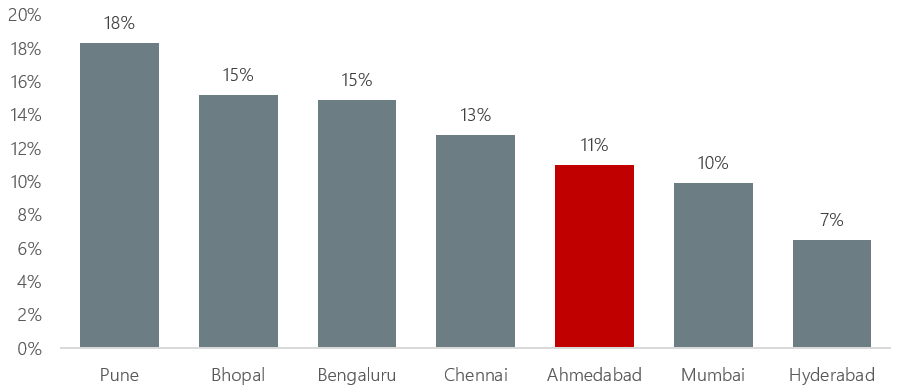
Corridor | Status | Expected year of operation | Mode |
Mumbai – Ahmedabad | Under construction | 2026 | High-speed rail |
Ahmedabad – New Delhi | Awaiting approval | 2031 | High-speed rail or hyperloop |
New Delhi – Ayodhya & Howrah | Detailed report being prepared | 2031 | High-speed rail or hyperloop |
Nagpur – Varanasi | Planned | 2041 | High-speed rail or hyperloop |
Hyderabad – Bangaluru | Planned | 2041 | High-speed rail or hyperloop |
Mysuru – Chennai | Detailed report being prepared | 2051 | High-speed rail or hyperloop |
Hyderabad – Mumbai | Planned | 2051 | High-speed rail or hyperloop |
Nagpur – Mumbai | Detailed report being prepared | 2051 | High-speed rail or hyperloop |
Patna – Guwahati | Planned | 2051 | High-speed rail or hyperloop |
New Delhi – Jammu | Planned | 2051 | High-speed rail or hyperloop |
Route
By 2031, if hyperloop technology is implemented as the high-speed mode of transportation between Ahmedabad and New Delhi, it can help reduce land acquisition impacts by making better use of existing road and rail corridors. This is due to its lean modularity and guideway flexibility. Effective interchange with high-speed rail services to Mumbai at Ahmedabad Junction or Sabarmati stations can further improve journey time performance. Additionally, intermediate stations can be added along the corridor in future stages without compromising travel times between New Delhi and Ahmedabad.
The figure below shows three different hyperloop routes. All of these routes have the same maximum speed of 700 km/h and the same end-to-end run time of 2 hours and 42 minutes. The percentage of at-grade, elevated, and underground sections range from 5% to 84% for all three routes, and the percentage using existing road and rail corridors is between 77% and 88% for all of them. The line length varies between the routes, with Route 1 (red dots) being 888 km, Route 2 (red and green dots) being 946 km, and Route 3 (all dots) being 1,284 km.
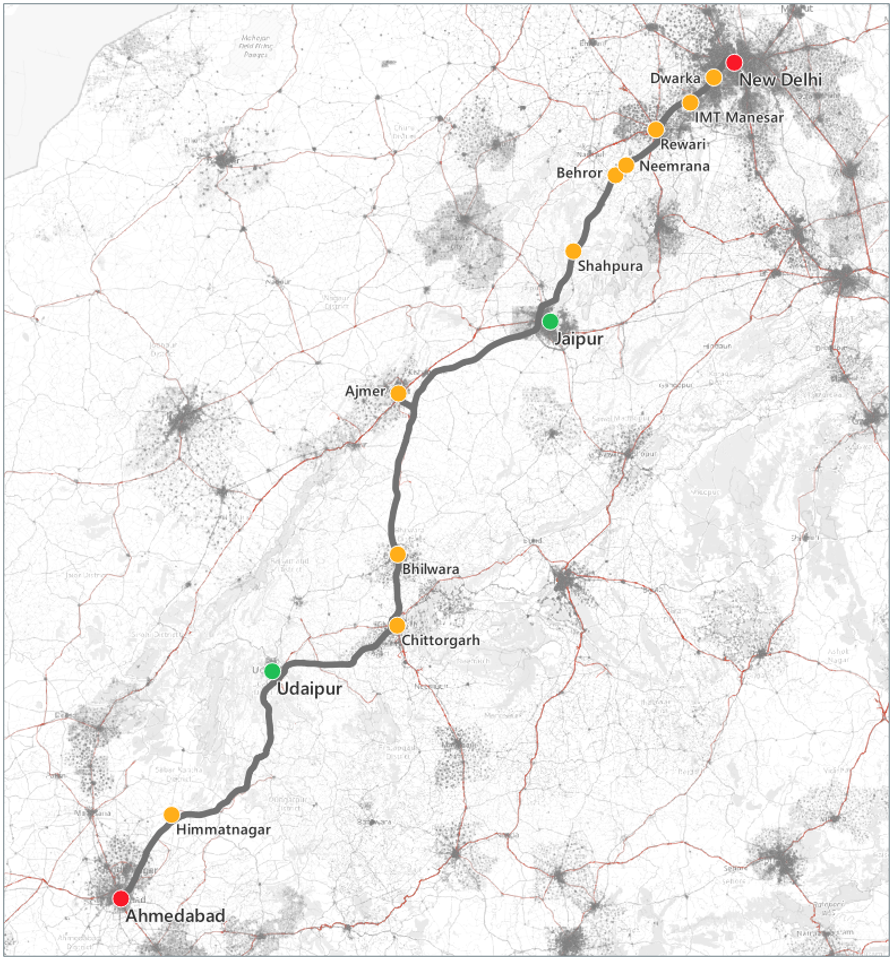
Expected demand
The estimated passenger volumes for the 2-hub and 4-hub hyperloop options between Ahmedabad and New Delhi were calculated based on extrapolated domestic passenger aviation data, with an annual growth factor of 6%, and redistributed trips from road, rail, and aviation towards hyperloop based on behavioral choice modeling.
Table showing the projected passenger volumes for the 2 and 4-hub hyperloop options.
Corridor | Annual passengers
(in 2039) | Annual passengers
(in 2069) |
2-hub option | 6.6 million | 39.4 million |
4-hub option | 17.3 million | 103.0 million |
Table showing redistribution of trips from road, rail, and aviation to hyperloop.
Corridor | Trips moved from roads | Trips moved from rail | Trips moved from flights |
2-hub option | -16% | -10% | -73% |
4-hub option | -39% | -15% | -46% |
The implementation of hyperloop between Ahmedabad and New Delhi would lead to a significant shift of passenger traffic (see chart below) from other modes of transportation, particularly domestic flights, due to the significant time savings that hyperloop offers (see table below). This shift in traffic would not only help in de-congesting the roads and freeing up rail capacity, but also aligns with the National Rail Plan objectives of boosting rail freight volumes.
Destination | |||
Mode | Udaipur | Jaipur | New Delhi |
Hyperloop | 1:20 | 2:22 | 2:42 |
Air | 7:41 | 4:29 | 4:51 |
HSR | 2:10 | 4:45 | 6:00 |
Road | 3:49 | 10:16 | 14:12 |
Rail | 10:37 | 12:04 | 16:25 |
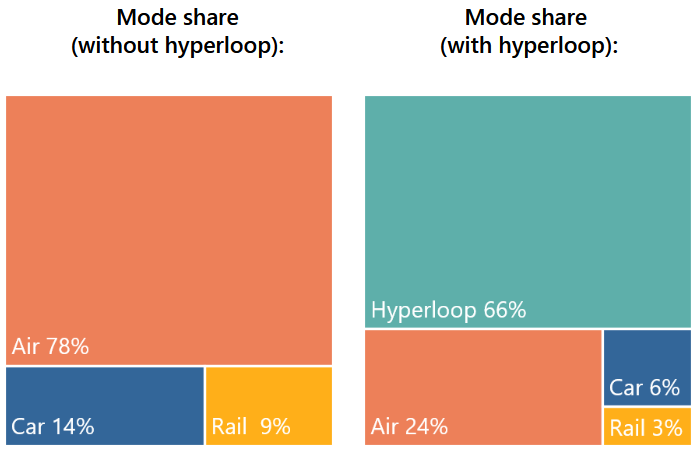
Costing and performance
The study found that all three hyperloop options, with 2, 4, and 14 hubs, have potential based on travel demand projections and travel choice changes between Ahmedabad and New Delhi. The average passenger fare is estimated to be ₹4.4 per passenger kilometer (€ 0.049), with an Ahmedabad to New Delhi ticket costing ₹3,907 (equals € 43.29). The 4-hub option of Ahmedabad, Udaipur, Jaipur, and New Delhi is considered the most cost-effective with a preliminary benefit-cost ratio of 2.16. The 14-hub option is recommended for long-term implementation due to its high accessibility impacts in the corridor.

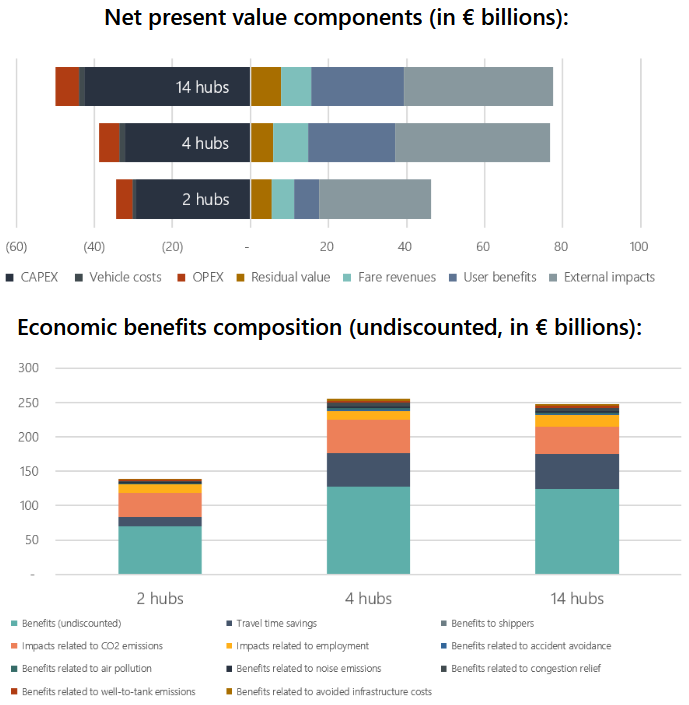
Conclusion and recommendations
This report discusses the potential of using hyperloop technology to connect Ahmedabad and New Delhi in India, with various hub options ranging from 2 to 14. The report includes projected passenger volumes, travel demand projections, and potential travel choice changes. It suggests that the 2, 4, and 14-hub options all have sufficient merit and recommends further project planning exercises through a collaborative partnership between Indian Railways and Hardt. The report also suggests considering hyperloop as an intervention case by 2031 and as an alternative to high-speed rail for future high-speed corridors across India.
Acknowledgements

